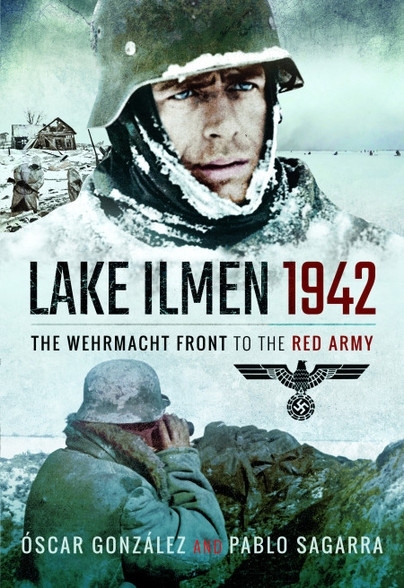| Title: | Lake Ilmen 1942 - The Wehrmacht front to the Red Army. |
| Writer: | Gonzalez, O. & Sagarra, P. |
| Published: | Pen & Sword |
| Published in: | 2019 |
| Pages: | 130 |
| Language: | English |
| ISBN: | 9781526719935 |
| Description | "Lake Ilmen 1942" is a remarkable book, because it doesn’t cover a unit of the Wehrmacht at the Eastern Front, instead, it describes a Spanish squad in German military service. This does mean that the title is slightly misleading, since the focal point is a Spanish volunteer squad and not the battle for Lake Ilmen in North-Western Russia. With the help of research across different archives, testimonies of surviving relatives and other documentation, the two authors have managed to correctly portray what happened to the Spanish ski battalion at Lake Ilmen in January 1942. The authors wanted to map out the experiences of the Spanish squad that fought at Lake Ilmen. In a detailed and personal way, they managed to describe the experiences of those involved. The narrative is occasionally interrupted by personal portraits or by additional explanation in separate frameworks. The compilers have succeeded in finding and locating several surviving relatives. There’s also an interesting discussion about the number of men that were active in the unit. The book lacks footnotes and endnotes, there is only a list of consulted literature. What’s so special about this book is that the authors managed to find as much information as they did and the fact that they’re able to provide an insight in this unknown aspect of the Second World War. This was an intense battle, as is proven by the appendix, amongst other things, in which you’ll find a list of those involved as well as the consequences. Nearly half of the unit became victim to the cold, which is an indication of the environment the Spanish volunteers found themselves in. The authors even traveled to the location to do their research and view the situation there. Still, it’s very noticeable that the book is written for a Spanish audience. It is presumed that the audience is familiar with the history of the Spanish Civil War in order to understand everything. It is also very clear that the book is meant for a Spanish audience from its nationalistic conclusion: "[…] Spaniards, Germans, Latvians, and Russians. Brought together under different circumstances, they wrote a history of blood and hardship, in many cases tinged with heroism. Some died and others were wounded or frostbitten, often with life-changing consequences. What they experienced allows the Europeans of today to resolve our differences peacefully and conserve the most noble and diverse elements of our military culture." Because the book is an English translation, more context is necessary for an international reader. The origin of some pictures is unclear and a little more self-reflection or a more critical stance would sometimes have been appropriate, although the lack thereof can partly be explained by the context in which the book is written. There has been a lot of communication with the families of those who were involved, for instance. On the other hand, certain pictures of the revisionist organisation HIAG have been used and a Facebook group as well as Wikipedia are noted as a source. A picture of a Slavic woman at the edge of the lake is nice, but its contribution to the book is unclear. Then, there are a few minor flaws here and there, like punctuation marks in the wrong sentence, but this isn’t very bothersome while reading. The aim to treat all parties equally has also failed, so neither the title nor the subtitle accurately covers the content, which is the biggest point of criticism. All in all, the authors did thorough research and this book is an informative addition to historiography. Because of their work this relatively unknown battlefield has been brought to our attention. For those who’d like to know more about the Spanish volunteers at the Eastern Front, this book will be an interesting read, specifically for those doing research on Ski battalions. The title doesn’t completely cover the content of the book. For those who’d like to gain more of an understanding of the battle for the lake this book won’t be sufficient as the sole source. To comprehend the complete context, more literature is required. |
| Rating: |    Good Good |
Information
- Translated by:
- Frank Hermans
- Article by:
- Samuel de Korte
- Published on:
- 07-07-2019
- Feedback?
- Send it!




